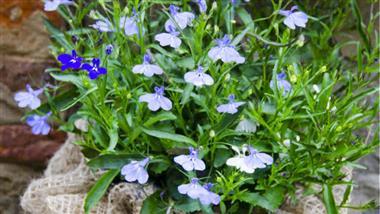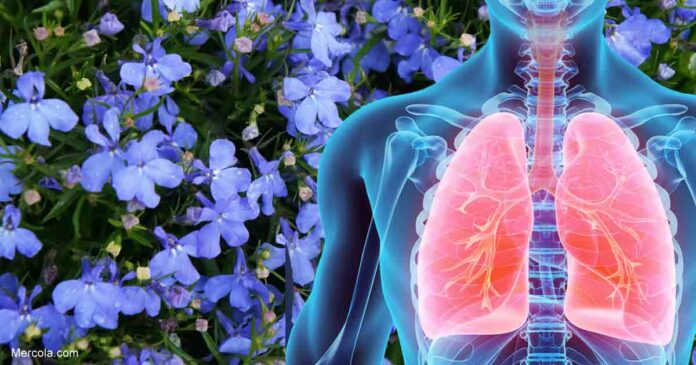Lobelia May Help in Respiratory Health and Muscle Relaxation

Story at-a-glance
- Lobelia can refer to a wide variety of flowering plants, with some botanists claiming that these varieties belong to a separate family, Lobeliaceae
- Because of the strong effects of lobelia when taken alone, some people choose to add it to their morning tea or other tea recipes
Lobelia (Lobelia inflata), or Indian tobacco, is a flowering herb that is named after the Belgian botanist, Matthias de l’Obel.1 It was formerly used as a substance to aid in smoking cessation, but has since been discontinued because of mixed results.
In a broader sense, lobelia can refer to a wide variety of flowering plants, with some botanists claiming that these varieties belong to a separate family, Lobeliaceae.2 One of the most common and popular variety of lobelias is the Lobelia inflata variety. Other varieties of lobelia plants include both Lobelia siphilitica and Lobelia cardinalis. These varieties normally can be distinguished from the Lobelia inflata through their flowers’ different colors.
Lobelia siphilitica is the most cultivated variety of this plant and is often called the “great blue lobelia” because of its vivid blue flowers, as opposed to the pale color of Lobelia inflata.3 Lobelia cardinalis is also much easier to differentiate because of the distinct bright red color of its flowers.4
Because of its dainty flowers, lobelia plants are usually planted in the garden or in window boxes to accentuate the ambience of the surroundings. However, its beauty sometimes leads to its nutritional components being overlooked.
Nutritional Benefits of Lobelia Inflata
Here are some of the benefits that you’ll likely receive when you start using lobelia therapeutically:
- Respiratory stimulant and antispasmodic — Lobelia may help the bronchial tubes relax, stimulating breathing and loosening phlegm.5
- Expectorant — Lobelia decreases the viscosity and promotes the excretion of mucus produced in the respiratory system. It works by triggering the cough reflex and is said to be more effective than other expectorants. It is commonly used to ease pneumonia and bronchitis.6
- Muscle relaxant — In small doses, lobelia may help constricted areas in the body relax, promoting better blood circulation. It may also aid in easing stomach cramps and other body tensions.7
Scientific studies have also linked lobelia to seizure prevention and neuron protection in those with Parkinson’s disease. In a 2014 study published in the journal Experimental and Therapeutic Medicine, lobeline, an alkaloid from lobelia, was found to inhibit dopamine transportation by blocking DAT-mediated uptake. This helps protect dopaminergic neurons from toxins that may trigger neuron damage and death.8
In a 2012 study from the Asian Pacific Journal of Tropical Biomedicine, mice were given isolated lobeline to measure the preventive effects the alkaloid has on pentylenetetrazol- and strychnine-induced seizures. The anticonvulsant properties of lobeline were found to be effective in increasing GABA, which helps offset seizures.9
How Do You Use Lobelia?
Applied externally, lobelia may help relax smooth muscles through its antispasmodic properties.10 It can also be added to your bathwater. For oral ingestion, lobelia can be dried and then brewed into tea.11 For best results, consult your physician to determine the appropriate dosage for you, so that you can avoid ingesting too little or too much of this herb.
Here’s How You Can Grow Your Own Lobelia
Lobelia is commonly planted in regions with low temperatures. But while they thrive well in cold climates, they are actually very sensitive to frost. Listed below is a step-by-step guide on how to successfully plant lobelia in your backyard either for ornamental or medicinal purposes:12
1. Start indoors roughly 10 to 12 weeks prior to the last frost in your region. Spread the tiny seeds just on top of the soil and water thoroughly. Place them in a warm, well-lit area.
2. The seedlings should pop up within a week or two, at which time you can begin thinning them out.
3. After the danger of frost is gone and the plants are at least 2 to 3 inches tall, transplant them to your garden — spacing them about 4 to 6 inches apart.
4. During hot and dry periods, water the plants frequently, especially if they are planted in containers.
Try This Recipe for This Muscle Relaxer Tea
Because of the strong effects of lobelia when taken in it’s pure form, some people choose to incorporate it into their various tea recipes. One such example is this recipe from Living Herbal Tea, which combines lobelia with other tea leaves:13
Muscle Relaxer Herbal Tea Recipe
Ingredients:
Procedure:
1. Combine the herbs. Steep 1 tablespoon of the herb blend in 8 ounces (approximately one standard mug full) of boiled water for five to seven minutes. Steeping too long or in water that’s too hot will cause the blend to become bitter.
2. Keep your cup covered while the tea steeps to make sure you don’t lose any of the flavor or healing properties.
3. Allow the tea to cool to a safe and comfortable temperature. Sip and enjoy.
Watch Out for These Contraindications and Possible Side Effects of This Herb
Even though it has a variety of health benefits when taken in moderation, lobelia may actually be poisonous when ingested in large quantities. It’s also poisonous for pets and other animals, and should be removed from the vicinity where these pets reside to avoid them from being harmed.14 If you have pets, do not plant this herb in an area that’s accessible to them. Some of the side effects that you may experience when you ingest lobelia include the following:15
• Nausea and vomiting
• Diarrhea
• Tremors
Severe symptoms may arise if you overdose on lobelia. If you observe the following side effects, immediately seek the attention of a healthcare professional:
- Low blood pressure
- Loss of consciousness
- Coma
- Fast heartbeat
- Convulsions
Lobelia should also be avoided when you suffer from the following conditions and diseases:
- High blood pressure and heart disease — Lobelia is a vasomotor stimulant and may cause an increase in blood pressure. This may worsen the symptoms of high blood pressure and could even cause irreversible damage.16
- Tobacco sensitivity — Lobelia contains lobeline, a substance that has the same effect of nicotine in the human body. This alkaloid contains about 5 to 20 percent of nicotine’s potency.17,18
Lobelia should not be used by people who suffer from liver or kidney disease, seizures or shortness of breath. Like other herbs and medications, lobelia should be avoided by pregnant and breastfeeding women, as it may cause adverse effects.19
Sources and References
- 1, 5, 6 Rodale’s 21st-Century Herbal, 2014
- 2 Department of Botany: University of Hawaii and Manoa, Lobeliaceae
- 3 Lady Bird Johnson Wildflower Center, Lobelia siphilitica
- 4 Missouri Botanical Garden, Lobelia cardinalis
- 7 The Herbal Apothecary: 100 Medicinal Herbs and How to Use Them, 2016
- 8 Exp Ther Med. 2014 Feb; 7(2): 375–378
- 9 Asian Pac J Trop Biomed. 2012 Jul; 2(7): 537–542
- 10 Encyclopedia of Herbal Medicine, 2016
- 11 Healing Teas: How to Prepare and Use Teas to Maximize Your Health, 1996
- 12 Gardening Know How, Annual Lobelia Plant: How to Grow Lobelia
- 13 Williams, Josh, Living Herbal Tea, The Healing Power of Lobelia Herbal Tea
- 14 Lady Bird Johnson Wildflower Center, Plant Database: Lobelia inflata
- 15 WebMD, Lobelia
- 16 Homeopathe Internationale, Lobelia Inflata
- 17 Small Animal Toxicology, 2013
- 18 Education of Cancer Healing Vol. 5
- 19 Novant Health: Midwifery Associates, Pregnancy Guidelines

